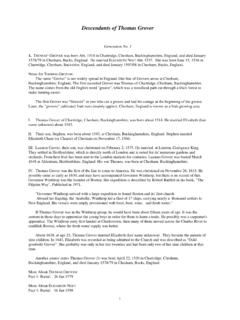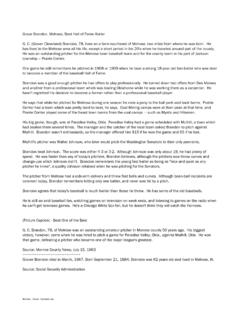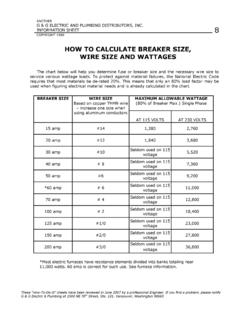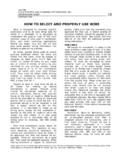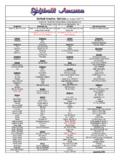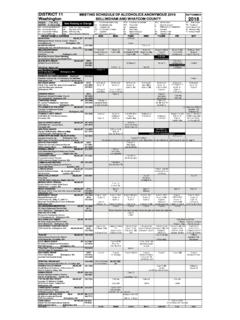Transcription of AIOS, CME SERIES (No. 23) Age Related Macular …
1 ALL INDIA OPHTHALMOLOGICAL SOCIETYAge Related MacularDegenerationAIOS, CME SERIES (No. 23)B. L. Sujata RathodArindam ChakravartiP. ManoharThis CME Material has been supported by thefunds of the AIOS, but the views expressed thereindo not reflect the official opinion of the AIOS.(As part of the AIOS CME Programme)Published April 2011 For any suggestion, please write to:Published by:ALL INDIA OPHTHALMOLOGICAL SOCIETYDr. Lalit Verma(Director, Vitreo-Retina Services, Centre for Sight)Honorary General Secretary, AIOSstRoom No. 111 (OPD Block ), 1 FloorDr. Centre, , Ansari Nagar,New Delhi 110029 (India)Tel.: 011-26588327; 011- 26593135 Email: Related Macular Degenerationntroduction1pidemiology3atho physiology of ARMD7lassification12 RMD Clinical Features19ationale & Modalities of Treatment32revention & Early Detection59 ContentsAll India Ophthalmological SocietyOffice Bearers (2008-10)PresidentDr.
2 Rajvardhan AzadPresident ElectDr. GroverVice President Dr. RajuHony. General SecretaryDr. Lalit VermaJoint SecretaryDr. Ajit Babu MajjiHony. TreasurerDr. Harbansh LalJoint TreasurerDr. Yogesh C. ShahEditor IJODr. Barun K. NayakEdior ProceedingsDr. Debasish BhattacharyaChairman Scientific CommitteeDr. D. RamamurthyChairman - ARC Dr. S. NatarajanImmediate Past PresidentDr. Babu RajendranOffice Bearers (2011-13)PresidentDr. GroverPresident ElectDr. RajuVice President Dr. Anita PandaHony. General SecretaryDr. Lalit VermaJoint SecretaryDr. Sambasiva RaoHony. TreasurerDr. Harbansh LalJoint TreasurerDr. Ruchi GoelEditor IJODr. S. NatarajanEdior ProceedingsDr. Samar Kumar BasakChairman Scientific CommitteeDr. D. RamamurthyChairman - ARC Dr. Ajit Babu MajjiImmediate Past PresidentDr.
3 Rajvardhan AzadAbout CME ..Age Related Macular Degeneration is an important cause of Blindness / Visual handicap among the elderly. The Prevalence has apparently increased possibly due to increased awareness and availability of newer therapeutic options. Although not completely understood, newer investigative modalities including Fluorescein Angiography, ICG, & OCT have helped in easily diagnosis of this disease. Gone are the days of laser photocoagulation (for Subfoveal / Juxtafoveal CNVM's). TTT has also met with virtually similar fate. PDT alone has limited or supplemental role. The arrival of Anti-VEGF's has created a ray of hope in the management of ARMD Avastin, Lucentis, Macugen are being increasingly used in the effective management their limitations being frequency of injections and predictability of response.
4 VEGF-Trap & Si-RNA may see light of the day soon. Hope with continued research, this debilitating disease of elderly will soon find a long lasting treatment & possibly a cure !!Thanks to efforts of Dr. Sujata Rathod & her colleagues for compiling the present CME SERIES for AzadPresident, AIOS(2010-11)Lalit VermaHony. General SecretaryAIOSA shok GroverPresident, AIOS(2011-12)ForewordDear Colleagues, is a medical condition which usually affects older adults resulting in loss of vision in the center of the visual field (the macula). It occurs in dry and wet forms. It is a major cause of visual impairment in older adults (>50 years). Macular degeneration can make it difficult or impossible to read or recognize faces, although enough peripheral vision remains to allow other activities of daily is a topic widely discussed and debated in vitreo-retina conferences and CMEs.
5 Most of the debates focus on the treatment aspect, especially the role of anti VEGF injections and photodynamic therapy. However a thorough knowledge of the pathophysiology and diagnosis of this condition is imperative before graduating to this issue of AIOS CME SERIES titled Age Related Macular Degeneration , the authors have presented the basics of this disease including pathophysiology, diagnosis and management in a simplified and illustrated manner. I am sure this will benefit all would like to appreciate the efforts of Dr. B L Sujatha Rathod, Dr. Arindam Chakravarti and Dr. P. Manohar in compiling an excellent practical guide on Age Related Macular Related Macular degeneration (ARMD)Prof. (Dr.) S. NatarajanChairman ARC (2010-11)Chairman and Managing DirectorAditya Jyot Eye Hospital of OphthalmologyMaharashtra University of Health SciencesVisiting Prof.
6 The Tamil Nadu MGR Medical UniversityAll India Opthalmological SocietyChairmanDr. S. 09920241419 Academic & Research Committee (2008-10)Members(East Zone) 09431121030Dr. GuptaDr. Ruchi Goel (North Zone) 09811305645(West 09850086491Dr. Deshpande(Central 09314614932Dr. Yogesh Shukla(South 09447227826Dr. AnthrayoseChairmanDr. Ajit Babu 9391026292 Academic & Research Committee (2011-13)Dr. Amit Khosla (North Zone) 09811060501 Members(East 09831019779Dr. Ashis K. Bhattacharya(West 09850086491Dr. Deshpande(Central 09412059188Dr. Gaurav Luthra(South 09849058355Dr. Sharat Babu ChilukuriIntroductionANATOMY OF THE MACULAThe Macular region is a specialized area of the central retina with a diameter of mm. This area can be divided into several regions: the foveola, fovea, parafoveal area, and perifoveal region.)))))))
7 The central portion of the macula contains the fovea and the foveola in a small depression in the internal surface of the retina. The foveola is located about 4 mm temporal and mm inferior to the center of the optic disc. Centrally, the foveola is mm in diameter and mm deep. The sides of the depression containing the foveola are called the clivus. In the foveola, the retina is only mm thick. The fovea measures mm in diameter. The thickness of the retina in the fovea is one half of what it is elsewhere, about mm. The only photoreceptors in the central fovea are cones. The central rod-free area within the fovea measures mm in diameter and contains 35,000 cones. There are 100,000 cones within the The cones in the fovea measure 80 m in length. Their outer segments are 45 m in length and 2 m thick, and their inner segments measure 20 to 30 m in length and 2 to 3 m in thickness.
8 This more closely approximates the shape and size of rods, which can measure up to 120 m in length. In contrast, cones in the area of the equator measure 37 to 40 m in length, and at the ora serrata they measure 6 m in length. The inner nuclear layer is only two cell layers thick at the edge of the fovea and is absent within the fovea. The internal plexiform layer, ganglion cell layer, and nerve fiber layer are also absent in the fovea. Most of the inner aspect of the fovea contains the processes of M ller cells. The internal limiting membrane is m thick at the periphery of the fovea and 10 to 20 nm thick within the fovea. The capillary free zone of the macula measures about mm in diameter. The entire vascular supply to the fovea is via the 11 AIOS CME SERIES , April 2011 The parafoveal central retina is an annular zone mm in width and along with the fovea measures mm in diameter.
9 It contains the largest number of nerve cells in the entire retina. The thickness of the photoreceptor layer in this portion of the retina is 40 to 45 m. There are 100 cones per 100 m in this area. The perifoveal central retina measures mm in width beyond the parafoveal retina. The outer boundary of this area is mm from the foveal center. There are 12 cones per each 100 m in the perifoveal central retina. The macula measures mm in horizontal width. This area corresponds to a central visual field subtending an angle of 18 .oThe retinal pigment epithelium (RPE) is a single layer of hexagonally shaped cells They reach out to the photoreceptor layer of the inner retina. Bruch's membrane separates the RPE from the vascular choroid. oUltrastructurally it is composed of five elements and througout life can accumulate metabolic debris Related to the build up of lipofuscin from the RPE.
10 The functions of the RPE include the maintenance of the photoreceptors, absorbtion of stray light, formation of the outer blood retinal barrier, phagocytosis and regeneration of visual pigment. oThe macula has the highest concentration of photoreceptors and is the the area where the RPE is most metabolically active and as a consequence most likely to suffer the consequence of enzymatic failure over time with the accumulation of metabolic debris and lipofuscin .RPE layer: 2 EpidemiologyIn the Beaver Dam Eye Study Risk FactorsBlue Mountains Eye Study (1995)In which the study population consists mostly of white men and women, prevalence of any AMD (referred to as age- Related maculopathy) was less than 10% in persons aged 43 to 54 years but more than tripled for persons aged 75 to 85 The Beaver Dam Eye Study demonstrated that progression to any AMD in a 10-year period was for persons aged 43 to 54 years and for those aged 75 years and The Beaver Dam Eye Study has identified soft, indistinct drusen and pigmentary abnormalities, which also increase in frequency with increasing age, as strongly predictive of advanced AMD 2.
